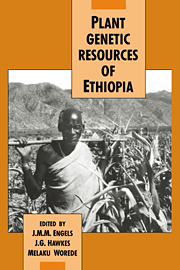Book contents
- Frontmatter
- Contents
- Contributors
- List of acronyms
- Preface
- Part I General introduction
- Part II The Ethiopian centre of diversity
- Part III Germplasm collection and conservation in Ethiopia
- 13 Theory and practice of collecting germplasm in a centre of diversity
- 14 A decade of germplasm exploration and collecting activities by the Plant Genetic Resources Centre/Ethiopia
- 15 Collection of Ethiopian forage germplasm at the International Livestock Centre for Africa
- 16 Germplasm conservation at PGRC/E
- 17 Documentation at PGRC/E
- Part IV Evaluation and utilization of Ethiopian genetic resources
- Index
16 - Germplasm conservation at PGRC/E
Published online by Cambridge University Press: 30 October 2009
- Frontmatter
- Contents
- Contributors
- List of acronyms
- Preface
- Part I General introduction
- Part II The Ethiopian centre of diversity
- Part III Germplasm collection and conservation in Ethiopia
- 13 Theory and practice of collecting germplasm in a centre of diversity
- 14 A decade of germplasm exploration and collecting activities by the Plant Genetic Resources Centre/Ethiopia
- 15 Collection of Ethiopian forage germplasm at the International Livestock Centre for Africa
- 16 Germplasm conservation at PGRC/E
- 17 Documentation at PGRC/E
- Part IV Evaluation and utilization of Ethiopian genetic resources
- Index
Summary
Introduction
Genetic conservation has arisen as a solution to some of the problems caused by Man in his social and agricultural relationship with the environment (Simmonds, 1979). Unwise exploitation of nature has caused an irreversible loss of variability and has become the major cause of worldwide genetic erosion. The seriousness and rapid expansion of the problem has created a universal need to collect and conserve genotypes that would no longer be available if not conserved today. This can best be achieved by maintaining a wide range of plant materials covering the maximum variability existing at present.
Taking into account these needs, and being aware of the enormous diversity of crops in Ethiopia, the Plant Genetic Resources Centre (PGRC/E), is currently working on the conservation of both orthodox and recalcitrant crops. At present, the centre holds 40000 accessions of 78 different species, including the germplasm material preserved in field genebanks.
Facilities, personnel and organization of the Conservation Division
The longevity of any conserved material depends upon the system of conservation used and this, in turn, is affected by the facilities existing at any given genebank and the quality of technical knowledge available. The inadequacy of the infrastructures for the maintenance and utilization of plant genetic resources remains the major limiting factor in the establishment of a genebank in a developing country. Storage facilities require large inputs in terms of construction, equipment and maintenance costs, as well as capable technicians and a reliable electricity supply.
- Type
- Chapter
- Information
- Plant Genetic Resources of Ethiopia , pp. 226 - 234Publisher: Cambridge University PressPrint publication year: 1991

